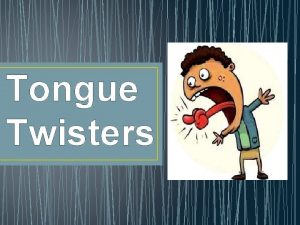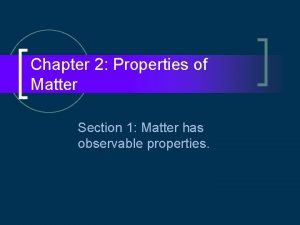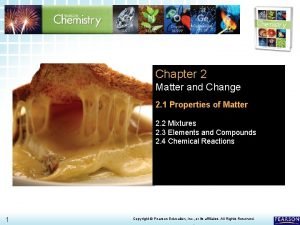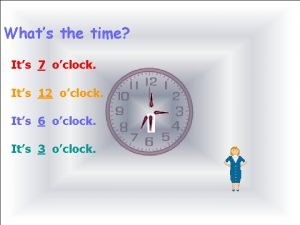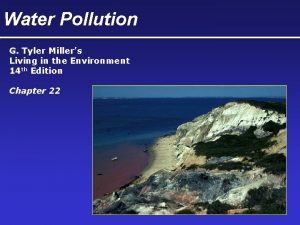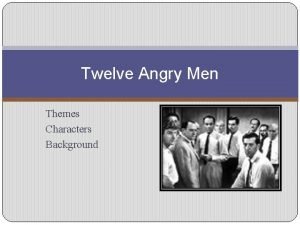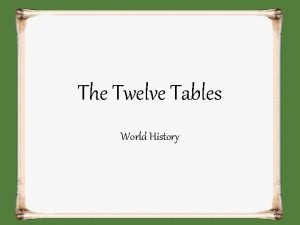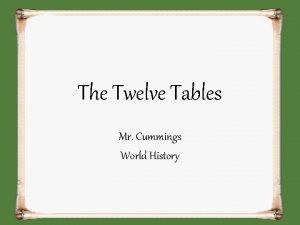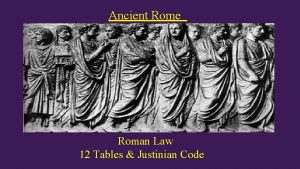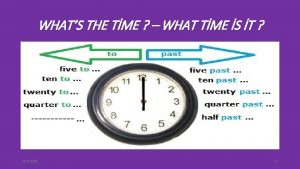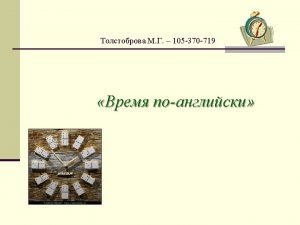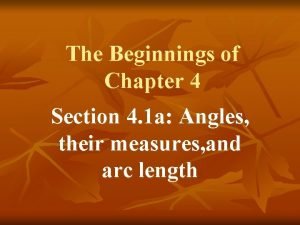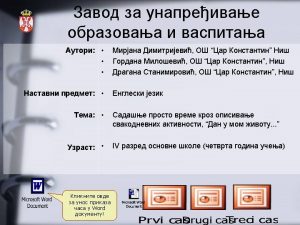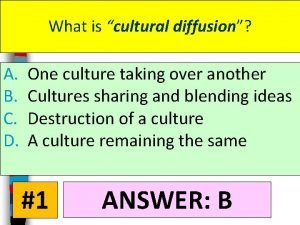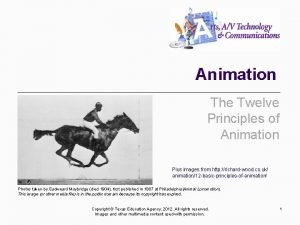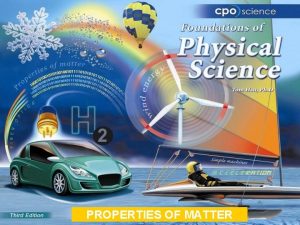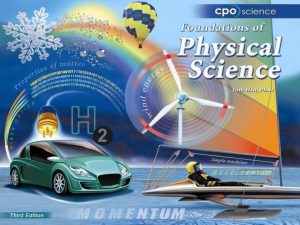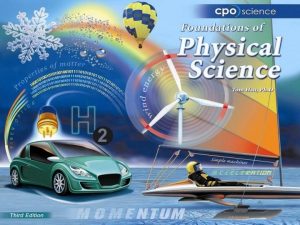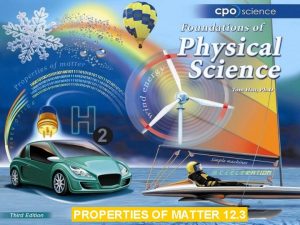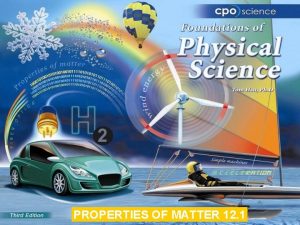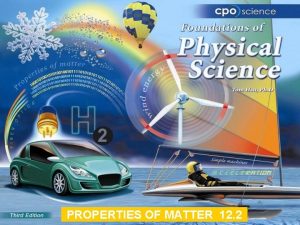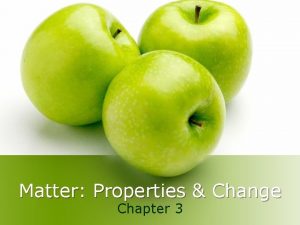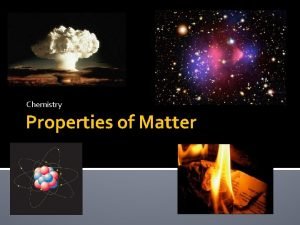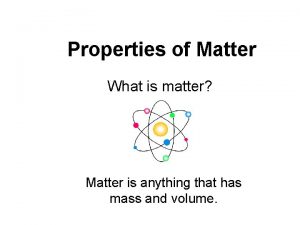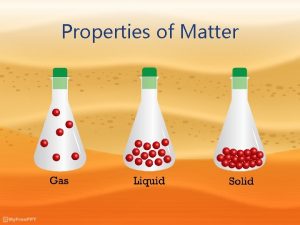Chapter Twelve Properties of Matter 12 1 Properties





















































- Slides: 53


Chapter Twelve: Properties of Matter Ø 12. 1 Properties of Solids Ø 12. 2 Properties of Fluids Ø 12. 3 Buoyancy

10. 1 The Nature of Matter Ø Matter is a term used to describe anything that has mass and takes up space. Ø Greek philosophers Democritus and Leucippus proposed that matter is made of tiny particles called atoms. Ø Atoms were an idea that few believed. Ø The first evidence was called Brownian motion for Robert Brown, who first noticed the jerky motion of tiny particles.

10. 1 Elements ØAn element is a pure substance that cannot be broken down into other substance by chemical or physical means. ØAll of the matter you are ever likely to experience is made from one or more elements in nature.

10. 1 Elements Ø For example, water can be broken down into its elements, hydrogen and oxygen, when energy is added.

10. 1 Atoms ØA single atom is the smallest particle that retains the chemical identity of the element.

10. 1 Compounds and elements ØCompounds are two or more different elements chemically bonded together.

10. 1 Examples of compounds Ø Compounds contain more than one type of atom joined together.

10. 1 Molecules ØA molecule is a group of two or more atoms joined together chemically.

10. 1 Mixtures How are Howmanyatoms molecules inare this in mixture? this mixture? ØMany substances you encounter are a mixture of different elements and compounds.

10. 1 Elements, compounds, and mixtures Can you distinguish between atoms and molecules in these images?

12. 1 Properties of Solids Ø Different kinds of matter have different characteristics. Ø Characteristics that can you observe directly are called physical properties. Ø Physical properties include color, texture, density, brittleness, and state (solid, liquid, or gas). Ex. Iron is solid at room temp.

12. 1 Properties of Solids Ø A physical change is any change in the size, shape, or phase of matter in which the identity of a substance does not change. Ø For example, when water is frozen, it changes from a liquid to a solid.

12. 1 Properties of Solids Ø Properties that can only be observed when one substance changes into a different substance are called chemical properties. Ø Any change that transforms one substance into a different substance is called a chemical change. Ex. If you leave a nail outside, it rusts.

12. 1 Properties of Solids The density of a solid material depends on two things: 1. the individual mass of each atom or molecule, Carbon atoms in diamond are packed very tightly. 2. how closely the atoms or molecules are packed together.

12. 1 Properties of Solids Ø Paraffin wax is also mostly carbon, but its density is only 0. 87 g/cm 3. Ø Paraffin’s carbon atoms are mixed with hydrogen atoms in long molecules that take up more space. The density of paraffin is low compared to diamond.

12. 1 Properties of Solids The atoms or molecules in a solid are arranged in two ways. 1. If the particles are arranged in an orderly, repeating pattern, the solid is crystalline. 2. If the particles are arranged in a random way, the solid is amorphous.

12. 1 Properties of Solids Ø Metals don’t look like “crystals” because solid metal is made from very tiny crystals fused together in a jumble of different orientations.

12. 1 Mechanical properties Ø“Strength” describes the ability of a solid object to maintain its shape even when force is applied.

12. 1 Mechanical properties ØTensile strength is a measure of how much stress a material can withstand before breaking.

12. 1 Mechanical properties ØHardness measures a solid’s resistance to scratching. How might you compare the hardness of these two metals?

12. 1 Mechanical properties ØElasticity describes a solid’s ability to be stretched and then return to its original size. ØBrittleness is defined as the tendency of a solid to crack or break before stretching very much.

12. 1 Mechanical properties ØA ductile material can be bent a relatively large amount without breaking. ØThe ductility of many metals, like copper, allow then to be drawn into wire.

12. 1 Mechanical properties ØMalleability measures a solid’s ability to be pounded into thin sheets. ØAluminum is a highly malleable metal.

12. 2 Properties of Fluids Ø A fluid is defined as any matter that flows when force is applied. Ø Liquids like water or silver are kinds of fluid.

12. 2 Pressure ØA force applied to a fluid creates pressure. ØPressure acts in all directions, not just the direction of the applied force.

12. 2 Forces in fluids ØForces in fluids are more complicated than forces in solids because fluids can change shape.

12. 2 Units of pressure ØThe units of pressure are force divided by area. ØOne psi is one pound per square inch.

12. 2 Units of pressure ØThe S. I. unit of force is the pascal. ØOne pascal (unit of force) is one newton of force per square meter of area (N/m 2).

12. 2 Pressure ØIf your car tires are inflated to 35 pounds per square inch (35 psi), then a force of 35 pounds acts on every square inch of area inside the tire. What might happen if you over-inflate a tire?

12. 2 Pressure ØOn the microscopic level, pressure comes from collisions between atoms. ØEvery surface can experience a force from the constant impact of trillions of atoms. ØThis force is what we measure as pressure.

12. 2 Pressure ØIn a car engine high pressure is created by an exploding gasoline-air mixture.

12. 2 Energy conservation and Bernoulli’s Principle ØStreamlines are imaginary lines drawn to show the flow of fluid. ØBernoulli’s principle tells us that the energy of any sample of fluid moving along a streamline is constant.

12. 2 Bernoulli’s Principle ØBernoulli’s principle says the three variables of height, pressure, and speed are related by energy conservation.

12. 2 Three Variables and Bernoulli’s Principle ØIf one variable increases along a streamline, at least one of the other two must decrease. ØFor example, if speed goes up, pressure goes down.

12. 2 The air foil ØOne of the most important applications of Bernoulli’s principle is the airfoil shape of wings on a plane. ØWhen a plane is moving, the pressure on the top surface of the wings is lower than the pressure beneath the wings.

12. 2 Viscosity ØViscosity is the property of fluids that causes friction. ØViscosity is determined in large part by the shape and size of the particles in a liquid.

12. 2 Viscosity and temperature ØAs the temperature of a liquid increases, the viscosity of a liquid decreases. ØIncreasing the kinetic energy of the substance allows the particles to slide past one another more easily.

12. 3 Buoyancy is a force ØBuoyancy is a measure of the upward force a fluid exerts on an object that is submerged. The water in the pool exerts an upward force that acts in a direction opposite to the boy’s weight.

12. 3 Volume and buoyancy ØThe strength of the buoyant force on an object in water depends on the volume of the object that is underwater. As you keep pushing downward on the ball, the buoyant force gets stronger and stronger. Which ball has more volume underwater?

12. 3 Weight and buoyancy ØWeight is a force, like any other pushing or pulling force, and is caused by Earth’s gravity. ØIt is easy to confuse mass and weight, but they are not the same. What is the rock’s weight? ØWeight is the downward force of gravity acting on mass. What is the rock’s mass?

12. 3 Weight and buoyancy ØIn the third century BC, a Greek mathematician named Archimedes realized that buoyant force is equal to the weight of fluid displaced by an object. ØA simple experiment can be done to measure the buoyant force on a rock with a spring scale when it is immersed in water.


12. 3 Weight and buoyancy ØIn air the buoyant force on the rock is 29. 4 N. ØWhen the rock was submerged, the scale read 19. 6 N. ØThe difference is a force of 9. 8 N, exactly the amount of force the displaced water exerts.

12. 3 Weight and buoyancy These blocks are the same total volume. Which block has more buoyant force acting on it? Which block weighs more in air?

12. 3 Weight and buoyancy ØBuoyancy explains why some objects sink and others float. ØWhether an object sinks or floats depends on how the buoyant force compares with the weight.

12. 3 Density and buoyancy ØIf you know an object’s density you can quickly predict whether it will sink or float. Which ball will sink in water? Which ball will float in water?

12. 3 Density and buoyancy Average density helps determine whether objects sink or float. Ø An object with an average density GREATER than the density of water will sink. Ø An object with an average density LESS than the density of water will float.

12. 3 Density and buoyancy What can you say about the average density of these blocks?

12. 3 Density and buoyancy ØWhen they are completely underwater, both balls have the same buoyant force because they displace the same volume of water.


12. 3 Boats and average density ØUse your understanding of average density to explain how steel boats can be made to float.

12. 3 Boats and average density ØIf you have seen a loaded cargo ship, you might have noticed that it sat lower in the water than an unloaded ship nearby. ØThis means a full ship must displace more water (sink deeper) to make the buoyant force large enough to balance the ship’s weight.
 Betty bought butter tongue twister
Betty bought butter tongue twister Chapter 2 section 1 classifying matter answer key
Chapter 2 section 1 classifying matter answer key 2 properties of matter
2 properties of matter Chapter 2 properties of matter answer key
Chapter 2 properties of matter answer key Section 1 composition of matter
Section 1 composition of matter What is white matter made of
What is white matter made of Composition of matter section 1
Composition of matter section 1 Dural septa
Dural septa Classification of matter section 1 composition of matter
Classification of matter section 1 composition of matter Gray matter and white matter
Gray matter and white matter What is grey and white matter
What is grey and white matter Ecological succession
Ecological succession What time is it it's 7 o'clock
What time is it it's 7 o'clock What are the terrible twelve water pollution
What are the terrible twelve water pollution Tcms morning show
Tcms morning show Themes in 12 angry men
Themes in 12 angry men 450 bc rome
450 bc rome Twelve tables
Twelve tables 12 principles of green chemistry with examples
12 principles of green chemistry with examples One two three four five six numbers
One two three four five six numbers Roman twelve tables laws
Roman twelve tables laws Lesson twelve saving and investing
Lesson twelve saving and investing Roman law code
Roman law code The 12 powerful words
The 12 powerful words It's quarter to twelve
It's quarter to twelve Five past quarter
Five past quarter 12 step facilitation handbook
12 step facilitation handbook It takes ten identical pieces to form a circular track
It takes ten identical pieces to form a circular track 7 twelve portfolio
7 twelve portfolio Josie is twelve last year
Josie is twelve last year High twelve international
High twelve international It's twelve to six
It's twelve to six There is twelve months in a year
There is twelve months in a year What was the main idea of the twelve tables?
What was the main idea of the twelve tables? Thirty five past four
Thirty five past four Book of the twelve
Book of the twelve Rectangular prism edges
Rectangular prism edges Twelve data
Twelve data The twelve virtues
The twelve virtues Twelve olympians symbols
Twelve olympians symbols Twelve 12 alwars names with pictures
Twelve 12 alwars names with pictures Roman number 12
Roman number 12 At ten to twelve
At ten to twelve Roman cultural diffusion
Roman cultural diffusion Twelve tables
Twelve tables It is seven in the morning
It is seven in the morning Twelve points of the apostles creed
Twelve points of the apostles creed Youtube the twelve days of christmas
Youtube the twelve days of christmas How do the twelve tables resolve unpaid debts
How do the twelve tables resolve unpaid debts Luke 9 1 2
Luke 9 1 2 Animation plus
Animation plus 2 properties of liquids
2 properties of liquids Properties of matter vocabulary
Properties of matter vocabulary Composition of matter concept map
Composition of matter concept map
